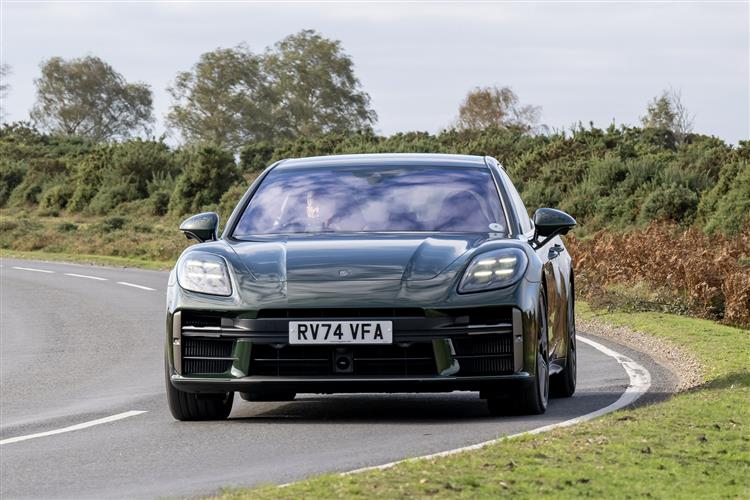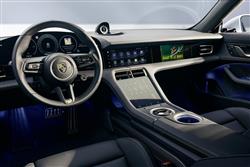NOT A QUESTION OF SPORT (some text hidden) --NONE--
By Jonathan Crouch
The Taycan Sports Saloon's heart is electric: its soul though, is very much that of a Porsche. Jonathan Crouch drives the improved version.
Ten Second Reviewword count: 91
What might the Porsche of full-electric performance cars be like? In this Taycan, back in 2020 we got our answer. Now it's been significantly improved - faster, longer-ranging and quicker-charging. As before, it's more powerful and faster than any other EV yet made. And as you might expect, it continues to set the handling benchmark for what a performance EV can be. Taycan pricing is exclusive of course. But if you're looking for the electrified state-of-the-art, you'll find it right here. In this review, we look at the Sports Saloon version.
Backgroundword count: 200
Fully electric performance cars are all much the same right? They all give you a great big heavy battery, a couple of electric motors and enough pulling power to tear up the tarmac. Oh yes and they all feel terrible the first time you throw one into a corner. In 2020 though, Porsche came up with something better: the Taycan. Launched in Sports Saloon form, the range was then expanded with Sport Turismo and Cross Turismo body styles; and all handled like no large luxury sports EV ever previously had. As a result, over 150,000 Taycans had been sold by the time this extensively revised model range was introduced in early 2024. This improved car doesn't look much different - and sits on the same J1 800v platform as before - but under the skin gets substantial changes in terms of drivetrain and charge capability: big enough, the brand hopes, to last the car until well into this decade. So big in fact that Porsche refers to this updated model as the 'J1.2'. As a result, though this revitalised Taycan continues to share much with its development cousin, Audi's e-tron GT, it's still the car to beat in its segment.
Driving Experienceword count: 634
There aren't many cars that can keep up with a Taycan, whatever drivetrain they might use. Quite a lot's new with this revised version, though for the time being, Porsche has decided not to adopt the kind of tri-motor drive system you'd find in, say, a Maserati GranTurismo Folgore. Instead, Zuffenhausen has redesigned this Taycan's rear electric motor, which is 10.4kg lighter than before, but up to 108PS more powerful, depending on the variant you're looking at. As for EV range, well that's up substantially. With the base rear-driven version we tried, it can be up to 421 miles, an increase of up to 109 miles on the original model. Helping here is an increase in battery size, Porsche having now standardised its largest 105kWh 'Performance Battery Plus' pack on this car (and discontinued the previous 89kWh base battery pack). Total power output is considerably higher across the range than it was with the original Taycan model. When fitted with the Sport Chrono Pack that most customers want and with launch control engaged, the base single-motor rear-driven Taycan now offers up to 435PS (26PS more than before). Which means that 62mph with launch control is dispatched in just 4.5s en route to 143mph. And that's at the bottom of the range. The power output for the mid-range dual-motor Taycan 4S is 598PS (68PS from before). As for the pricier variants, the mid-level GTS version has 700PS, the strangely-named 'Turbo' variant offers 884PS (203PS more than the original model) and the fiery Turbo S develops an impressive 952PS (188PS more than before). At the top of the Sports Saloon part of the range sits a Turbo GT version with a frankly ludicrous turn of speed - 1034PS with launch control engaged; yes really. 0-62mph takes just 2.2s en route to 180mph. Back in the real world on a mainstream model like the base rear-driven version we tried, a push-to-pass feature on the now-standard mode switch gives a quick burst of acceleration should you need it. What else? Well as before, there are four drive modes - 'Range', 'Normal', 'Sport' and 'Sport Plus'; and three chassis settings - 'Normal', 'Sport' and 'Sport Plus'. Air suspension is now mandatory (the old coil-spring set-up's no longer offered) and the twin-chamber air springs are matched to the new dual-valve dampers recently introduced in the Panamera. This more greatly varies the car's behaviour between its 'Comfort' and 'Sport' modes and allows for variable ride heights at high speeds. There are three ride height settings - 'Lift', 'Normal', 'Lowered' and 'Low'. Now optional is a clever new 'Porsche Active Ride' system which enables individual control of each damper via a small electrically-driven compressor. Roll and pitch through the bends can then be countered, without the need for the physical anti-roll bars used in the previously-available PDCC anti-roll system. As before, the most difficult task the engineers had here was in disguising what as usual on an EV is a prodigious kerb weight - in this case around 2.3-tonnes. Plenty's been thrown at that problem as part of this update, but the weight savings (which we'll detail for you in our 'Costs' section) aren't substantial. You'll feel that through the bends - but not as much as you might expect to; this car still sets the handling benchmark amongst luxury sporting EVs. And if you tick a few well chosen dynamic options boxes, it's even better. Turbo and Turbo S models get Porsche's Torque Vectoring Plus rear differential, which is optional elsewhere in the range and through turns is able to over-speed the outer rear wheel to help the Taycan's cornering balance. Rear-wheel steering is optional across the line-up (and standard on the Turbo S and Turbo GT). All of this tech is co-ordinated by a clever Porsche 4D Chassis Control set-up.
To see the full road test text contact us on 0330 0020 227
Pictures (high res disabled)

.jpg)
|
.jpg)
|

|
Statistics (subset of data only)
Min |
Max |
|
Price: |
£88,200.00 (At 13 Jun 2025, Taycan) |
£189,200.00 (At 13 Jun 2025, Turbo GT) |
Insurance group 1-50: |
50 |
|
Max Speed (mph): |
143 (Taycan) |
180 (Turbo GT) |
0-62 mph (s): |
4.5 (Taycan) |
2.2 (Turbo GT) |
Electric WLTP-Rated Driving Range (miles): |
324 |
|
Length (mm): |
4963 |
|
Width (mm): |
1966 |
|
Height (mm): |
1379 |
|
Boot Capacity (l): |
366 |
|
Power (ps): |
408 (Taycan) |
1034 (Turbo GT) |
Scoring (subset of scores)
Category: Hybrid, Plug-in, Electric & Hydrogen
| Performance | |
| Handling | |
| Comfort | |
| Space | |
| Styling, Build, Value, Equipment, Depreciation, Handling, Insurance and Total scores are available with our full data feed. | |



